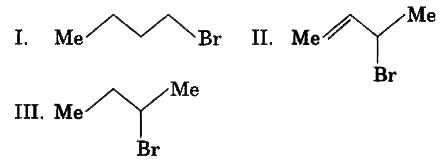Rate limiting SN1 follows the sequence

True statement about sequence on the basis of assumption that R contains 3 different groups is : Solution in Telugu
more stable carbocation, greater is in the proportion of racemization
the more nucleophilic the solvent greater in the proportion of inversion
In above sequence (b) represent separately solvated, pair ofions
All of these
The correct Answer is:D
Informative question [All are correct]
Topper's Solved these Questions
- 5C ALKYL HALIDES BOOK - MS CHOUHANCHAPTER - 5C ALKYL HALIDES EXERCISE - LEVEL-2
3 Videos
- 5C ALKYL HALIDES BOOK - MS CHOUHANCHAPTER - 5C ALKYL HALIDES EXERCISE - LEVEL-2 (SUBJECTIVE PROBLEMS)
1 Videos
- ALCOHOL,ETHERS AND EPOXIDESBOOK - MS CHOUHANCHAPTER - ALCOHOL,ETHERS AND EPOXIDESEXERCISE - SUBJECTIVE PROBLEMS
1 Videos
Similar Questions
The following organic halide derivatives (A to J) are reacted in ethanol solution with each of the nucleophiles : acetate, methylthiolate, cyanide and hydroxide anions. Six possible results from these combinations of reactants are designated (1) through (6) below:
Write the number corresponding to your best estimate of the outcome ofeach reaction in the appropriate answer box below.

View Solution
X = Total number of substitution and elimination product(s). Find the value of X.
View Solution
Maximum number of moles of Ac2O consumed by reactant (A) is :
View SolutionIf the sum of n terms of sequence S_(n)=(n)/(n+1)
View SolutionA sequence contains the terms S_(1),S_(2),S_(3),...S_(n), where S_(2)=2&S_(n)=S_(n-1)+2S_(2) What is the value of S_(18)
View SolutionConsider the sequence of natural numbers s_(0),s_(1),s_(2),... such that s_(0)=3,s_(1)=3 and s_(n)=3+s_(n-1)s_(n-2) then
View SolutionRate limiting SN1 followingthe sequence The statement about sequence on the basis of assumption thatR contains 3 different groups is
 .
.
View SolutionRate limiting SN1 follow s the sequece
δ⊕R−δBr⇔R⊕Bro−⇔R⊕BrΘ⇔R⊕⇔BrΘ
True statement about sequece n th ebasic of assumption that R contains 3 Different group is : (A) more stable carocation ,greater is in the protion of rcemization
(B) the more nucleophilic the solvent greaataer in the proportion of inversion
(C) in above sequence (B) represent separatly solvets ,paie of ions
(D) All of these
View SolutionDNA sequence is the basis of grouping organisms in
View SolutionFor a sequence, if Sn=nn+1 then find the value of S10.
View SolutionA sequence is defined for all positive integers by sn=2sn−1+n+1 and s1=3. What is s4?
View SolutionDNA sequence is the basis of grouping organisms in
View SolutionIf Sn=n⋅(2n2+9n+13)6 ( Sn = sum of first n terms of the sequence) then the value of ∑∞i=11r√(Sr−Sr−1)
View Solutionनिम्न ब्रोमाइडों पर विचार कीजिए

SN1 अभिक्रियाशीलता का सही क्रम है।
View SolutionIf for n sequences Sn=2(3n−1), then the third term is
View Solution( S_(N) 2 or S_(N) 1) In nucleic substitution reactions, the reactivity of alkyl halide follows which of the following sequence?
View Solution
